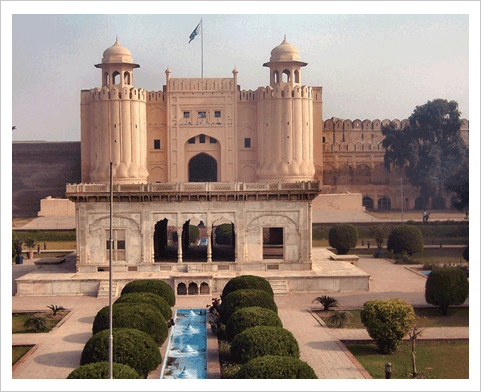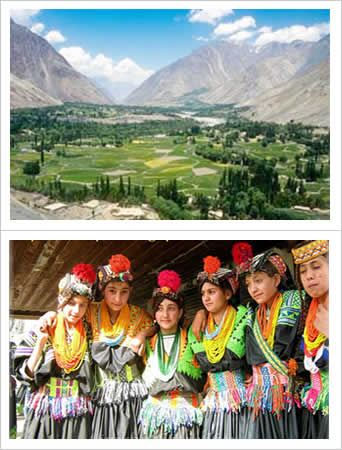Kalash tours
 No golden tombs, no fancy ziggurats. Four thousand years ago city builders in the Indus Valley made deals, not war, and created a stable, peaceful, and prosperous culture.” No golden tombs, no fancy ziggurats. Four thousand years ago city builders in the Indus Valley made deals, not war, and created a stable, peaceful, and prosperous culture.”
The railway linking Lahore to Multan in Pakistan is 4,600 years old. In truth, the rails were laid down in the middle of the nineteenth century, but to build the railway bed, British engineers smashed bricks from crumbling buildings and rubble heaps in a town called Harappa, halfway between the two cities. Back in 1856, Alexander Cunningham, director of the newly formed Archeological Survey of British India, thought the brick ruins were all related to nearby seventh-century Buddhist temples. Local legend told a different story: the brick mounds were the remnants of an ancient city, destroyed when its king committed incest with his niece. Neither Cunningham nor the locals were entirely correct. In small, desultary excavations a few years later, Cunningham found no temples or traces of kings, incestuous or otherwise. Instead he reported the recovery of some pottery, carved shell, and a badly damaged seal depicting a one-horned animal, bearing an inscription in an unfamiliar writing.
That seal was a mark of one of the world’s great ancient civilizations, but mid-nineteenth-century archaeologists like Cunningham knew nothing about it. The Vedas, the oldest texts of south Asia, dating from some 3,500 years ago, made no mention of it, nor did the Bible. No pyramids or burial mounds marked the area as the site of an ancient power. Yet, 4,600 years ago, at the same time as the early civilizations of Mesopotamia and Egypt, great cities arose along the flood plains of he ancient Indus and Saraswati rivers in what is now Pakistan and northwest India. The people of the Indus Valley didn’t build towering monuments, bury their riches along with their dead, or fight legendary and bloody battles. They didn’t have a mighty army or a divine emperor. Yet they were a highly organized and stupendously successful civilization. They built some of the world’s first planned cities, created one of the world’s first written languages, and thrived in an area twice the size of Egypt and Mesopotamia for 700 years.Sp let’s see the great Alaxander foot step ,

follwing the footsteps of alexander the great
Chitral – Swat – Jhelum – lahore – Multan –sukkur - Gawader
| Day 01 |
Islamabad |
Arrive Islamabad and transfer to the hotel for overnight. |
| Day 02 |
Kalash |
Flight to Chitral, after short sightseeing drive to Bamboret, Largest among the three Kalash villages. Overnight at Hotel. |
| Day 03 |
Kalash |
Visit villages of Kalash, the black robed people, known as the descendents of Alexander’s legions who entered into the Indo sub-continent through these remote valleys. |
| Day 04 |
Swat |
Drive to Swat, through the Lawari pass and upon arrival at Saidu Sharif, the capital of Swat Valley transfer to the hotel. |
| Day 05 |
Swat |
Excursion to Madyan-Bahrain. Afternoon visit remains of Butkara and Swat museum. Overnight at hotel. |
| Day 06 |
Jhelum |
Drive on the Grand Trunk road to Jhelum, where the battle of Hydaspes (River Jhelum) was fought between Alexander’s army and Raja Porus. Overnight at hotel |
| Day 07 |
Lahore |
Visit Rohtas Fort and drive to Lahore. Afternoon visit, Lahore Museum, Fort and Badshahi mosque. Overnight at hotel. |
| Day 08 |
Multan |
Drive to Multan, where one of the last battles were fought and a poisoned arrow struck Alexander, making him sick and eventually lead to his death. Sightseeing and overnight at hotel. |
| Day 09 |
Sukkur |
Continue driving along the Indus to Sukkur and overnight. |
| Day 10 |
Hyderabad |
Drive to Mohenjodaro, visit site and museum. Later continue drive on the Indus highway to Hyderabad. Overnight at hotel. |
| Day 11 |
Karachi |
Drive to Karachi, visit world’s largest necropolis at Makli Hills and Shahjehan mosque at Thatta. Arrive Karachi and overnight at hotel. |
| |
| Day 13 |
Gawadar |
Excursion to Jiwani along the scenic coastal line near the Iranian border and visit the town of Ganz. |
| Day 14 |
Karachi |
Flight to Karachi and sightseeing including Dhobi Ghatt, Clifton beach. Later transfer to the airport for return flight. |
|